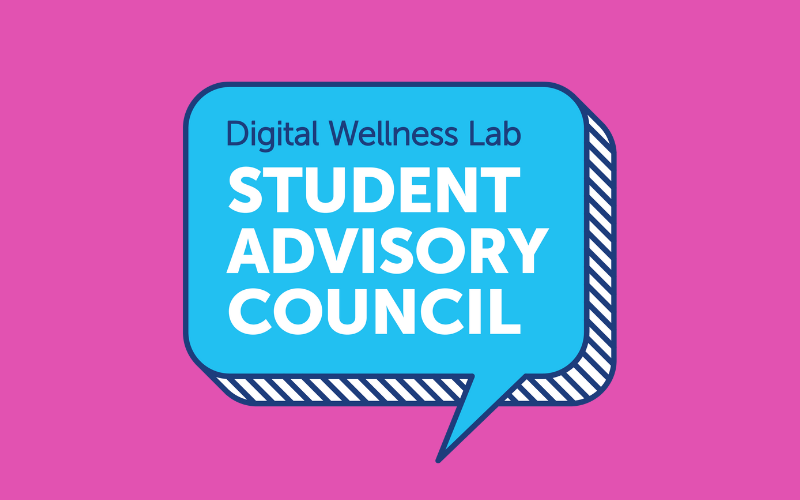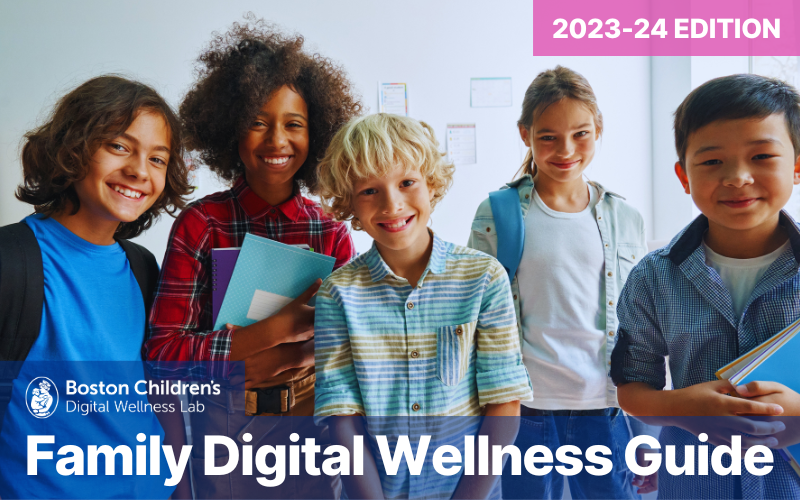Family Digital Wellness Guide
Grade School to Tween (Ages 6-12)
Guide Exploration with Balance and Safety in Mind

As children enter middle childhood, their curiosity grows, and their world begins to expand beyond home and family. During this stage, technology often becomes a bigger part of their lives, from educational tools at school to games, apps, and social interactions at home. This increased exposure presents an excellent opportunity to help children develop responsible and intentional habits with technology. Setting clear family guidelines, such as agreed-upon screen time limits or device-free zones, can provide structure while encouraging balance between digital and offline activities.
This is also a time when children start to build independence, so actively involving them in discussions about technology use is key. For example, you might explore educational apps or games together, empowering them to make productive choices while still feeling supported. At the same time, open communication about online safety becomes increasingly important. Teaching kids how to recognize inappropriate content, avoid oversharing personal information, and respond to uncomfortable situations helps them navigate the digital world with confidence.
Encouraging creativity and critical thinking is another important consideration at this stage. Help your child see technology as a tool for learning and self-expression, whether they’re coding, creating digital art, or working on a school project. By staying involved in their digital activities, you can guide them toward meaningful and positive experiences, laying the groundwork for good habits that will serve them well into adolescence.
Next section: What the Science Says
What the Science Says
Grade-schoolers (6-9)
As their school years begin, children become physically stronger, more independent, and much more aware of themselves and their bodies.
They may test boundaries, break rules, and try on new identities as they seek acceptance by the group. Friends become increasingly important for fun as well as for social development.
Physically, grade-schoolers undergo rapid periods of change; there is typically wide variation in height and weight between children of the same age. With the beginning of rapid physical changes, grade-schoolers may begin to feel self-conscious, and some research suggests that media ideals can predict lower body image and eating problem development.
Children in grade school need at least one hour of physical activity daily and the development of healthy eating and exercise habits is particularly important. Research has shown that spending over 1.5 hours watching television may be a risk factor for obesity, and YouTube channels popular with children are more likely to feature food that is less nutritious.
Grade school children begin to develop more mature attention spans, with the ability to focus on a single task for up to an hour by age 9. They can begin to make more complex decisions, reflect and problem-solve, and contribute meaningfully to their family and peer groups. Children at this age begin to develop self-regulation and self-awareness, understanding themselves in relation to others and managing their emotions.
As they become more comfortable with using media and are developing their self-regulation and independence, children can begin to more productively use screen media. Interactive and engaged co-viewing with parents and peers can offer opportunities for relationship-building and learning.
Developmentally optimal screen media can have benefits like improved academic performance and increased literacy skills. But academically supportive media is not the only type of media that can reap benefits for this age group. Playing video games is extremely popular, especially among boys, and gameplay with friends can help develop meaningful relationships. Gameplay may even support resiliency, e.g. in practicing skills such as dealing with failure.
Over 90% of grade school kids report regular television watching and living in a home with access to smartphones. At the same time, parents and caregivers report being concerned about the effects of smartphones and other technology on their children.
Overall, personal phone ownership is still uncommon in this age group. However, by age nine, 32% of children have their own phone. The digital connection and ease of contact that comes with a smartphone can make parents and children feel safer. But within peer groups, that constant connection may also create opportunities for cyberbullying, which can result in negative mental health effects.
In school, 1-to-1 device programs are now extremely common, which requires responsibility not just by remembering to bring it home and to school, but being aware of the content they are consuming and how they are using the device both in and out of school.
Although many children in this age group are not yet using social media, and age restrictions limit access to accounts for children in this age group, some grade-schoolers are using social media sites and applications. Recent research suggests that those who start using platforms like Snapchat and Instagram before age ten were more likely to have problematic digital behaviors than those who started as tweens or teens.
Parents and caregivers should evaluate the time spent and content consumed on the media their children are engaging with and how that time seems to affect their schoolwork, relationship with friends and family, and things like attention or self-esteem.
As children become more independent and learn self-regulation, parents can start including their children in conversations about advertisements, online social interactions, and responsible use of media (see best practices below for guidance).
At the end of grade school, children will be transitioning into a period where many children rapidly gain access to connected digital spaces — parents should communicate in a developmentally appropriate way about the negative and positive opportunities screens give us so they are prepared to make a smooth transition when they are given personal devices like smartphones.
Ideal Use
For grade-schoolers, screens should be used in moderation, with purpose, and in balance with time spent on a variety of non-screen activities like physical activity.
Tweens (10-12)
Around ages 10-12 (also known as the “tween” years), puberty has begun for some, but not for others. With the increased hormones of early adolescence, children begin to experience notable physical changes with increased variability in height among kids of the same age. Most are excruciatingly self-conscious.
As their brains become more capable of logical and abstract thought, children this age enjoy practical tasks and problem-solving. In the United States, children often transition from elementary to middle school during the tween years. This transition brings new independence, expectations, supports, and structures that can differ markedly from what children experienced in early elementary school. As their brains have matured, tweens are able to tackle higher-level schoolwork while at the same time spending more energy on developing peer groups and social structures. Being perceived as popular and cool takes on great importance. This is critical to tweens in digital contexts, too.
At this age, many children are getting their first phone; in one of our Pulse Surveys, we found that the average age children receive their first phone is 10 years old. By age 12, 71% of children own their own smartphone.
Although children in this age group are not technically allowed to use social media platforms, it’s still quite common: 38% of tweens (expanded in the research to include 8-12 years old) use social media, and 18% do so every day. Research shows that tweens who get less “likes” on social media report more negative emotions, but positive offline relationships may help buffer that effect.
Social relationships continue to increase in importance as the child seeks greater independence, with non-romantic friendships often dominating. Video games are popular places for tweens, particularly boys, to “hang out” and spend time with their friends, playing the game while simultaneously chatting in the game or through a video chat. Children at this age may seek to dress, speak, and act like close peers or idolized celebrities. As children begin to forge their own path and identity online, they may be drawn to influencers who share their interests on platforms like YouTube and other video streaming apps that continue to be extremely popular with this age group. Marketing of products like video games, toys, and food is often present in the influencer videos tweens consume, and could affect their dietary and toy/game preferences.
While testing the limits of their independence, tweens need boundaries and the safety of their relationships with parents and other caregivers. At this age, children can begin to use media more independently, but still need the mentorship and oversight of adults as they get their own devices and accounts and learn to navigate more social and interactive media forms. In fact, many tweens themselves endorse parental rules surrounding managing smartphone use.
Families should work together to make decisions about using digital media that are in the best interest of each child’s balance and wellness. This includes having clear rules about phone and device ownership and use for all family members (modeling positive media habits like no phones while eating together, for example!), and having conversations about evaluating the content they consume in video games, on social media, and in online videos (see best practices below for guidance).
Ideal Use
For pre-adolescent “tweens,” continue to monitor and guide their use of screens and set clear expectations and boundaries to prepare them to transition into more independent digital media use as teenagers.
Next section: Best Practices
Best Practices for Digital Wellness
Birth-Preschool
Children in their grade school and tween years are increasingly independent, with maturing ability to reason. When making decisions about which devices, applications, and programs they will watch and use, discuss with your child why they want to use these media, what, if any, your concerns are, and why you have those concerns. Supporting your child’s growing independence while still having rules about time and content can decrease your child’s risk of problematic media use. You can still make the decision that is in your child’s best interest, even if it’s not in line with their desires, but it’s important for them to feel heard and to understand why you have made the decision.
Grade school aged children and tweens appreciate boundaries and fairness; they want parental support to help them navigate digital milestones like smartphone ownership. Sitting down with your child to craft a media use agreement that addresses how everyone in the household uses television, tablets, computers, smartphones, game consoles, and other devices can set expectations and opportunities for using media independently and together. It’s important that children have input on the agreement and that everyone signs on.
Children this age will be highly aware of adult use patterns that seem hypocritical — for example, a parent who does not allow their child to play video games but spends hours doing so themself — and will challenge rules they feel are unfair. By creating a media use agreement for the entire family — and modeling healthy online habits — as your child begins to use devices and online applications, you are helping them to develop healthier, more balanced engagement with the digital world.
Most apps, streaming services, and games require that users under a certain age have accounts with specific permissions and preferences. Rather than setting up these accounts for your child, or allowing them to do it independently, we recommend talking through privacy and safety considerations of internet spaces and setting accounts up together so you can discuss the decisions to be made, what their preferences might be, and why you are requiring certain permissions and limits to be in place. Some applications even have family or group account options which allow a parent or caregiver to set privacy and screen time settings that can be modified as your child ages and learns more digital skills to regulate their own digital use.
When you start your child with a new device or platform, ask them to share their passwords with you. Talk with them about how their online behaviors can always be seen by others. You won’t need to check in on them constantly, but they will understand that access is expected as they learn regulatory skills useful in their life, both online and off. As children move into more public online spaces like social media, it is important that they understand what they say and do online can affect other people.
Homework presents a great opportunity to build focused habits and self-regulation, even in the earliest years of schooling. Multitasking with media, even background media like doing homework on a laptop while the TV is on, can have negative effects on your child’s academic outcomes like the quality of their work or their grades — it’s difficult to focus on what you’re working on if your favorite show is on!
- Create a quiet, comfortable space with good lighting and no distractions for your child to do school work.
- Support your child’s effective study habits by setting expectations for use of screens during homework and study time — place phones and tablets in another room, turn off televisions, and set boundaries for how laptops are to be used if they are required for schoolwork.
- Having access to a school-provided personal device is, particularly after COVID-19-induced changes, extremely common even in elementary and middle school. Children use these devices primarily for schoolwork, but may also use them for entertainment. Recent research suggests that greater home use of the device for entertainment may have negative impacts on academics and result in increased conflict between parents and children. Talk to your child about setting boundaries and rules in your family about how school devices can be used at home.
As they get older, children will begin to develop a deeper understanding of advertising, influencers, and disinformation. But it can be difficult for many young people (even beyond middle school) to decipher what the people, companies or producers behind advertisement or information campaigns want them to do (e.g. buying certain products) or think (e.g. mis/disinformation). The development of media literacy skills as children grow up, starting early in their media use, can continue to benefit them as they begin to engage with a wider variety of devices and platforms.
Co-engagement with media with your child offers an opportunity to build their skills in critical thinking about what they are seeing.
- When an advertisement comes on, you can ask your child what they think the ad is trying to get them to do, who they think created it, and what is attractive (or not) about it.
- When a persuasive message is shared, through a political campaign, a social media post, or even the news, you can ask your child who they believe created the message, what the content creators want them to think or believe, why, and whether or not they agree with that message.
Learn more about media literacy and digital citizenship in our research brief.
When they are online, even the children of the most involved parents will find themselves making choices quickly and often on their own. You can help them to make healthy choices by building their decision-making skills both on- and offline.
- Teach them to make pro/con lists when faced with a decision. Ask them about what the positive benefits may be of a particular path and what the potential negative consequences could be of that same path. Help them to talk through their calculation of where the benefits may outweigh the negatives.
- Talk through your own decision-making process. For example, when faced with a decision, even about mundane things like what to wear, you can talk to your child about what you’re considering, why, and how you arrive at your final choice.
- If you want to post content about your child on your social media accounts, ask for consent to do so! Older tweens report wanting to have a say in what their parents post about them — consulting them before you post will build trust, model positive media behavior, and help them start thinking about how to safely and respectfully post on social media before they have accounts themselves.
- Let them make safe mistakes. Video games are one venue to practice making — and rebounding from — mistakes without dangerous consequences. Ask your child what went wrong and what they might do differently next time. Older children may be able to talk about how they could apply this learning to other situations.
Older children and tweens may be particularly vulnerable to making appearance comparisons to friends, but also to highly curated and often altered images online. When tweens talk to their peers about their appearance, it may result in higher levels of internalizing media ideals of what they feel they should look like and make them more prone to body surveillance and self-objectification. And while there have been online movements to require disclaimers on posted images and videos that have been edited, early research suggests they are not that effective at helping tweens. For grade-schoolers and tweens, there is evidence that interactive and gender-specific media literacy interventions may help reduce some of these media effects on body image and unhealthy weight management behaviors.
Co-view social media with your child and talk about what they are seeing and how it makes them feel. Older children may understand that what they see online has been created for an audience and is unlikely to reflect reality.
Even though they are not yet old enough for social media, many grade-schoolers and tweens have access to it, through friends, their own accounts, or parental accounts, and research has begun to explore how this age group is using it.
Modeling healthy digital media use for your children will go a long way in helping them to develop good habits. As the saying goes, while they may only hear 1% of what you say, they see 100% of what you do.
- Model prosocial behavior for them through your own social media accounts by following positive accounts, sharing videos and posts with your child that demonstrate the best parts of human interaction (funny dog and cat videos are always a win), and avoiding making posts that attack others.
- Put down your own devices, preferably in another room, during mealtimes, before bed, and while engaged in conversations. Try to avoid device use during family time, such as when you’re watching a movie together, playing a board game, or attending your child’s sporting event. Research shows that “phubbing” (phone snubbing) and persistent “technoference” (technology interfering with social interactions) may affect younger children’s executive functioning skills or decrease parent-child interaction during tasks. Tweens who feel that their parents are frequently distracted by technology were more likely to report higher conflict in their parental relationships and lower feelings of parental emotional support.
Smartphones are not just telephones, they are powerful computers. On average, parents now provide a first smartphone to their child around age 10, often to ensure their child has the ability to easily communicate with the parents and stay safe when away from home. A smartphone offers children nearly unrestricted access to everyone and everything online, however, and should be treated as the powerful tool that it is.
- Set expectations for milestones that your child can reach to show they are mature enough for device ownership, rather than just considering age and if their friends have a smartphone. Talk with your child about why they want the device, how they will use it, and what rules surrounding the use you each feel are appropriate once the device is theirs.
- Set the expectation that independence will be a process; at first, you may require that your child share their passwords with you and understand that you will be checking in on their device, but as they get older and show responsible digital habits, those monitoring techniques may change to ease your child into more autonomy-driven expectations.
- Consider starting your child with a flip phone or a smartwatch which has only voice and text capability for communication, with additional parental controls often available like emergency contact or location sharing. Present this as an opportunity to demonstrate responsibility and good choices to show they are ready for a smartphone. Set expectations and milestones for what behaviors you consider responsible and consider creating an agreement that tracks habits you think show readiness for a smartphone.
- Resist the urge to check in with your child when they’re at school. School is your child’s opportunity to establish their independence. You also want to model responsible use and calling your child outside of emergencies will demonstrate an acceptance of phone use during school hours. A study showed that parental monitoring/control apps sent the most notifications to young smartphone users during school hours, so make sure to set notifications to avoid unnecessary interruptions.)
Learn more in our Family Guide to a Child’s First Cell Phone
Social media companies make their money by collecting personal data on their users, and there is a federal law that protects children under age 13 from such data collection. While kids 12 and under are technically not allowed on social media, research shows that 38% of children aged 8-12 have ever used social media, and 18% use it everyday.
Social media offers opportunities for connection across geographic, cultural, and social divides, however they also can be filled with misinformation, hate, bullying, hyper-sexualization, and other potentially harmful influences. Parents may choose to support their children’s social media access when they feel their child can manage that environment. For some children, this may mean delaying access to social media beyond the age of 13.
While most children in these age groups are not yet using social media, research suggests that those who start using platforms like Snapchat and Instagram before age 10 were more likely to have problematic digital behaviors than those who started as tweens or teens. But the good news is that, overall, many younger users were engaging in positive digital behaviors rather than negative ones, so if your child does have access to social media during elementary school or as a tween, there should be the expectation of close monitoring; making clear rules with the child; discussing how social media should and should not be used; and remaining open for questions, concerns, and non-judgmental help when the child needs it.
Learn more in our Parent’s Guide to a Child’s First Cell Phone
With greater focus on peer relationships comes increased opportunities for bullying and exclusionary behaviors, like ostracism or shunning. Elementary and middle-school children can be the victim (one who is bullied), the perpetrator (the one doing the bullying), the bystander (one watching and allowing the bullying to happen), or any combination at different times.
Kids who are bullied online are at greater risk than their peers for depression and anxiety. They may obsessively watch their device, hide it when a parent walks by, withdraw from friends and family, and/or become upset after being online or when asked to get offline.
- Talk with your child on a regular basis about what they are seeing and hearing both online and in person. You can ask them questions such as “I heard from a friend that there is a lot of cyberbullying at their child’s school. Does that happen at your school?” or “Have you heard of anyone being cyberbullied? What happened?”
- Report bullying when you hear about it, and talk to your child about what they can do if they see someone being cyberbullied or which trusted people they can talk to if they are being cyberbullied. Unfortunately, children and teens may be concerned about retaliation from the bully or losing access to their devices, so ensure your child understands what will happen should they find themselves in a cyberbullying situation.
Learn more about how to recognize and address cyberbullying in our Parent’s Guide to Cyberbullying.
As they reach puberty, children naturally become more interested in exploring their own sexuality. Children may use the internet to search for sexual images and information in order to deepen their own understanding of sex and sexuality, with many children first encountering pornography online while they are still in elementary school.
- Provide young people with access to accurate information about sexuality and sexual behavior without shame and help them to understand the importance of a caring relationship to healthy, fulfilling sexual activity.
- Though it’s likely to make parents and kids uncomfortable, it’s important to begin having conversations about the objectification of women and inaccuracy of sexual behavior portrayed in pornography. In a recent study of teens’ experiences with pornography, only 1 in 3 reported that someone asked for consent and more than half said they had seen violent or aggressive pornography, making conversations about the reality of sexual behavior critical before your child reaches an age where they will explore their sexuality as a teen or young adult.
- For children with access to a connected device, talk with them about the dangers of sexting (see best practices in Teens and Young Adults for more information).
Gaming is an extremely popular activity for many grade-schoolers and tweens with their interest transcending the simple on-screen activity. Games are places where friends can hang out together or talk while playing together, and many children are watching video game content on platforms like YouTube — 32% of boys aged 6-8 watched Minecraft-related YouTube content, and while only 9% of girls in this age range did, that percentage jumps to 43% for 9-12 year old girls. It is clear that gaming activities outside of merely participating in gameplay are important for both girls and boys, although the interest in certain games may not be the same across genders in each age group.
Action games, some of which can be violent, are among the most popular games with children. Research on the effects of playing these games on behavioral patterns is inconclusive, but does indicate at least short-term negative effects on aggression, empathy, and schoolwork. But research also indicates that action-oriented and open-world games can have positive effects on one’s attention and ability to learn.
We recommend that parents avoid violent games with their younger children and, if they decide to allow tweens to play these games, that they do so alongside their children, observe how they behave both when playing and after the game, and talk about what is happening on the screen. If your child is asking to play these games, talk to them about why they are interested in playing. Overall, encourage games that are nonviolent and developmentally appropriate.
Recent research suggests that how the game is played, not only the content, may be a key piece in understanding the effects on children — older grade-schoolers and tweens who played Fortnite together exhibited more prosocial behaviors than peers who had played alone or played a nonviolent pinball game. Ask your child what they are playing, what they like about it, and if you can play with them. You can ask that they teach you how to play and then ask questions along the way (“What should I do next?” “Which button do I push to make my next move?”). If they are playing social games, such as Roblox, Fortnite, or Minecraft, you can ask them to introduce you to their friends and to tell you more about them and how they met.
Video games can offer a bonding and shared coping opportunity for families of grade school and pre-adolescent children. Children love to be experts and to share their expertise with others, particularly when they can teach their parents something.
Healthy children require physical activity, creativity, and in-person interactions with peers and family members. Excessive screen media exposure has been correlated with obesity and long-term negative health outcomes. Encourage — and model — outdoor play, sports, art, and reading, as well as mindful, directed digital activities.
Next section: Additional Resources
Additional Resources
-

Key Takeaways from Our 2024 Pulse Survey on the Nuance of Social Media Use
In our most recent Pulse Survey, we asked 1,505 young people between the ages of 15 and 22 about aspects of their social media use using a unique approach…
-

Family Guide to Teaching Kids and Teens Essential Digital Skills
In a world where toddlers are swiping through screens and tweens are building their online personas, young people need to be equipped…
-

Family Guide: 5 Strategies for Setting Digital Media Boundaries and Guidelines for Kids
Digital media have become deeply embedded in our kids’ lives, with screen time often beginning during toddlerhood. These technologies can provide cognitive, social, and emotional benefits, such as expanded learning…






